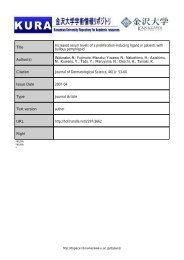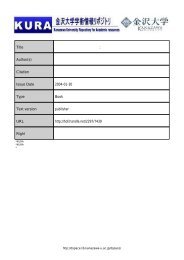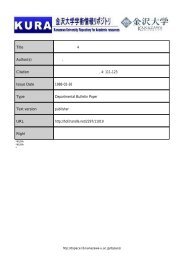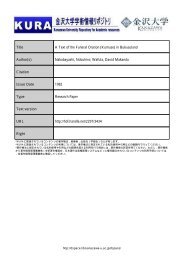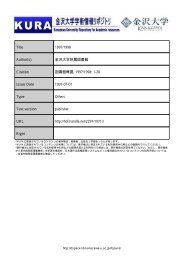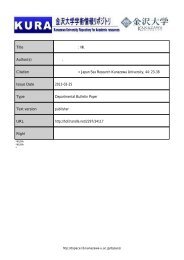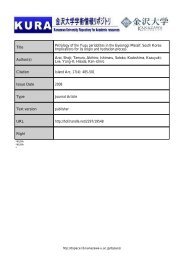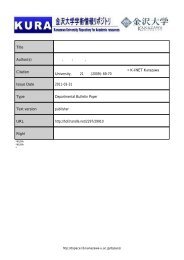Title The Study on Myanmar trade ware:Martaban Jar and ... - 金沢大学
Title The Study on Myanmar trade ware:Martaban Jar and ... - 金沢大学
Title The Study on Myanmar trade ware:Martaban Jar and ... - 金沢大学
You also want an ePaper? Increase the reach of your titles
YUMPU automatically turns print PDFs into web optimized ePapers that Google loves.
<strong>金沢大学</strong>考古学紀要 30 2009, 101-136. <str<strong>on</strong>g>The</str<strong>on</strong>g> study of <strong>Myanmar</strong> <strong>trade</strong> <strong>ware</strong> : <strong>Martaban</strong> jar <strong>and</strong> white dish<br />
from fourteen <strong>Martaban</strong> jars <strong>and</strong> opaque white glazed sherds<br />
from four dishes have been excavated from archaeological sites<br />
of Japan. <str<strong>on</strong>g>The</str<strong>on</strong>g>se glazed sherds of <strong>Martaban</strong> jars were excavated<br />
in four places, sites from Fukuoka, Oita, Nagasaki <strong>and</strong> Okinawa<br />
Prefecture. Indeed, <strong>Martaban</strong> jar means big glazed jar produced<br />
from different kilns of <strong>Myanmar</strong> which had been <strong>trade</strong>d from<br />
<strong>Martaban</strong> or Mottama harbor to other countries. A few glazed<br />
sherds from dishes of <strong>Myanmar</strong> opaque white <strong>ware</strong>s were<br />
unearthed from the sites of Osaka <strong>and</strong> Hirado. <str<strong>on</strong>g>The</str<strong>on</strong>g>se findings<br />
are also w<strong>on</strong>derful although these are a few numbers.<br />
Actually all the glazed sherds unearthed from the sites of Japan<br />
are broken fragments from different parts of several glazed jars<br />
<strong>and</strong> a few dishes. <str<strong>on</strong>g>The</str<strong>on</strong>g>se broken sherds are fixed as much as<br />
possible by identifying the same characteristics of glaze, fabric<br />
<strong>and</strong> size to rec<strong>on</strong>struct the original positi<strong>on</strong>.<br />
Actually, <strong>Myanmar</strong> ceramics had not been <strong>trade</strong>d directly from<br />
<strong>Martaban</strong> harbour to Japan. <str<strong>on</strong>g>The</str<strong>on</strong>g>se would be arrived to Japan<br />
together with other Southeast Asian ceramics <strong>and</strong> Chinese <strong>ware</strong>s<br />
through by maritime <strong>trade</strong> route from <strong>Martaban</strong> harbour to such<br />
Southeast Asian countries of Thai, Ind<strong>on</strong>esia, Philippine etc.<br />
<str<strong>on</strong>g>The</str<strong>on</strong>g> <strong>trade</strong> <strong>Myanmar</strong> ceramics <strong>and</strong> the excavated sites unearthed<br />
these finds are menti<strong>on</strong>ed in the following map 1 <strong>and</strong> table 1.<br />
1.1 Excavated sites in Okinawa Prefecture<br />
Glazed sherds of <strong>Martaban</strong> jars were uncovered from the<br />
two main sites, Shuri-jo castle <strong>and</strong> Shinan-iseki in Okinawa<br />
prefecture. Although it is hard to guess the c<strong>on</strong>structi<strong>on</strong> period<br />
of Shuri-jo castle, findings of the excavati<strong>on</strong> indicates that<br />
Shurijo Castle had existed since the sec<strong>on</strong>d half of 14th century.<br />
<strong>Martaban</strong> jars were found in 5 excavated areas, Koufukum<strong>on</strong>,<br />
Kobikim<strong>on</strong>, Uekim<strong>on</strong>, Jo-no-shita area <strong>and</strong> Agari no Azana in<br />
Shurijo castle.<br />
Another site, Shinan-iseki, is located at Aza-nishi-zato No.345,<br />
Hirara Township in Miyakojima Isl<strong>and</strong>. Archaeological findings<br />
of local <strong>and</strong> <strong>trade</strong> ceramics were unearthed from these excavated<br />
sites. <str<strong>on</strong>g>The</str<strong>on</strong>g> excavati<strong>on</strong>s have been carried out several times by<br />
leading Okinawa Prefectural Archaeological Research Centre.<br />
Most of the brown glazed-sherds of <strong>trade</strong> ceramics unearthed<br />
from Shinan-iseki site could be presumed the products of China.<br />
<str<strong>on</strong>g>The</str<strong>on</strong>g> glaze-colours were from olive to black colour. <str<strong>on</strong>g>The</str<strong>on</strong>g> fabrics<br />
were mixed with grains in such colours of dark reddish brown,<br />
black or white etc. ( 沖縄県立埋蔵文化財センター 2003).<br />
1.1-1 <strong>Myanmar</strong> glazed jar from excavati<strong>on</strong> in Okinawa<br />
Prefecture (Figure 1)<br />
22 glazed sherds from 7 glazed jars could be c<strong>on</strong>firmed from<br />
the excavati<strong>on</strong>s of Okinawa Prefecture. <str<strong>on</strong>g>The</str<strong>on</strong>g>se sherds had been<br />
found at different places of adjacent area from the same site of<br />
− 102 −<br />
Shuri-jo-castle <strong>and</strong> Shinan-iseki site.<br />
All of the jars were made by potter’s wheel, <strong>and</strong> there were<br />
some lines of potter’s wheel marks comm<strong>on</strong>ly found around the<br />
mouth <strong>and</strong> body of the interior <strong>and</strong> <strong>on</strong> the exterior. White clayslip<br />
was comm<strong>on</strong>ly applied under the glazed part <strong>on</strong> the exterior<br />
before glazing.<br />
a. Okinawa.MM-1 (Fig.1.a): <str<strong>on</strong>g>The</str<strong>on</strong>g> two glazed sherds of Okinawa.<br />
MM-1 are from the same glazed jar. <str<strong>on</strong>g>The</str<strong>on</strong>g>se sherds are exhibited<br />
in Okinawa Prefectural Museum. Thus the scale drawing was<br />
adopted from figure 42, page 65 of the excavati<strong>on</strong> report of<br />
Shuri-jo castle, 2001. <str<strong>on</strong>g>The</str<strong>on</strong>g> everted mouth is round <strong>and</strong> thick. A<br />
small grooved line of potter’s wheel is at the end of rounded<br />
mouth or at the joint to the neck at interior. This feature is<br />
comm<strong>on</strong>ly found from other <strong>trade</strong> <strong>Martaban</strong> jars <strong>and</strong> local<br />
<strong>Myanmar</strong> glazed jars. Although the full part of neck could<br />
not get chance to fix, the neck would be slightly l<strong>on</strong>g. <str<strong>on</strong>g>The</str<strong>on</strong>g><br />
diameter of mouth is 34cm <strong>and</strong> the body is 80cm. It is with the<br />
largest body size am<strong>on</strong>g the <strong>trade</strong> <strong>Martaban</strong> jar in Japan. <str<strong>on</strong>g>The</str<strong>on</strong>g><br />
black glazed was thickly applied <strong>on</strong> the exterior but interior<br />
was unglazed. Its fabric colour is dark gray mixed with white,<br />
reddish brown <strong>and</strong> dark brown rough grains. As decorati<strong>on</strong>, a<br />
vertical relief line of white clay-slip is <strong>on</strong> the horiz<strong>on</strong>tal line<br />
of white clay-slip <strong>on</strong> the body at the exterior. It is <strong>on</strong> the upper<br />
porti<strong>on</strong> of the body, <strong>and</strong> perhaps the similar decorated design<br />
might be <strong>on</strong> the lower porti<strong>on</strong> of the body.<br />
b. Okinawa.MM-2 (Fig.1.b): It could be seen that the nine<br />
glazed sherds with the same colour of glaze <strong>and</strong> fabric are from<br />
the same <strong>on</strong>e. <str<strong>on</strong>g>The</str<strong>on</strong>g>se were uncovered from the different places of<br />
adjacent areas of Koufukum<strong>on</strong>, Jo-no-shita area <strong>and</strong> inside the<br />
st<strong>on</strong>e-heap of Shuri-jo castle. <str<strong>on</strong>g>The</str<strong>on</strong>g>se sherds are from the body to<br />
the waist part or lower body. <str<strong>on</strong>g>The</str<strong>on</strong>g> black glaze is <strong>on</strong> the exterior,<br />
<strong>and</strong> white clay slip was clearly seen the lost part of glaze. <str<strong>on</strong>g>The</str<strong>on</strong>g><br />
fabric is bright reddish brown colour <strong>and</strong> mixing with rough<br />
grains with white colour, reddish brown <strong>and</strong> dark brown. <str<strong>on</strong>g>The</str<strong>on</strong>g>re<br />
are found the horiz<strong>on</strong>tal relief line or white slip line <strong>on</strong> the two<br />
sherds, <strong>on</strong>e from upper body <strong>and</strong> the other from lower body.<br />
Probably, some decorated design of white slip clay would be<br />
arranged inside the frame between of two horiz<strong>on</strong>tal relief lines.<br />
c. Okinawa. MM-3 (Fig.1.c): <str<strong>on</strong>g>The</str<strong>on</strong>g> sherd of glazed jar Okinawa.<br />
MM-3 is a fragment of mouth part <strong>and</strong> two fragments of<br />
body part near shoulder. <str<strong>on</strong>g>The</str<strong>on</strong>g> mouth part was found from the<br />
renovated layer of Agari-no-Azana site. <str<strong>on</strong>g>The</str<strong>on</strong>g> two body parts<br />
were found surrounding areas of Kobikim<strong>on</strong> site <strong>and</strong> from<br />
Uekim<strong>on</strong> sites. Although the neck part could not be found,<br />
these glazed sherds could be seen from the same <strong>on</strong>e because<br />
of the same fabric <strong>and</strong> glazed c<strong>on</strong>diti<strong>on</strong>. <str<strong>on</strong>g>The</str<strong>on</strong>g> everted mouth is<br />
round <strong>and</strong> thick with Diameter of 27.8cm. <str<strong>on</strong>g>The</str<strong>on</strong>g> diameter of body




